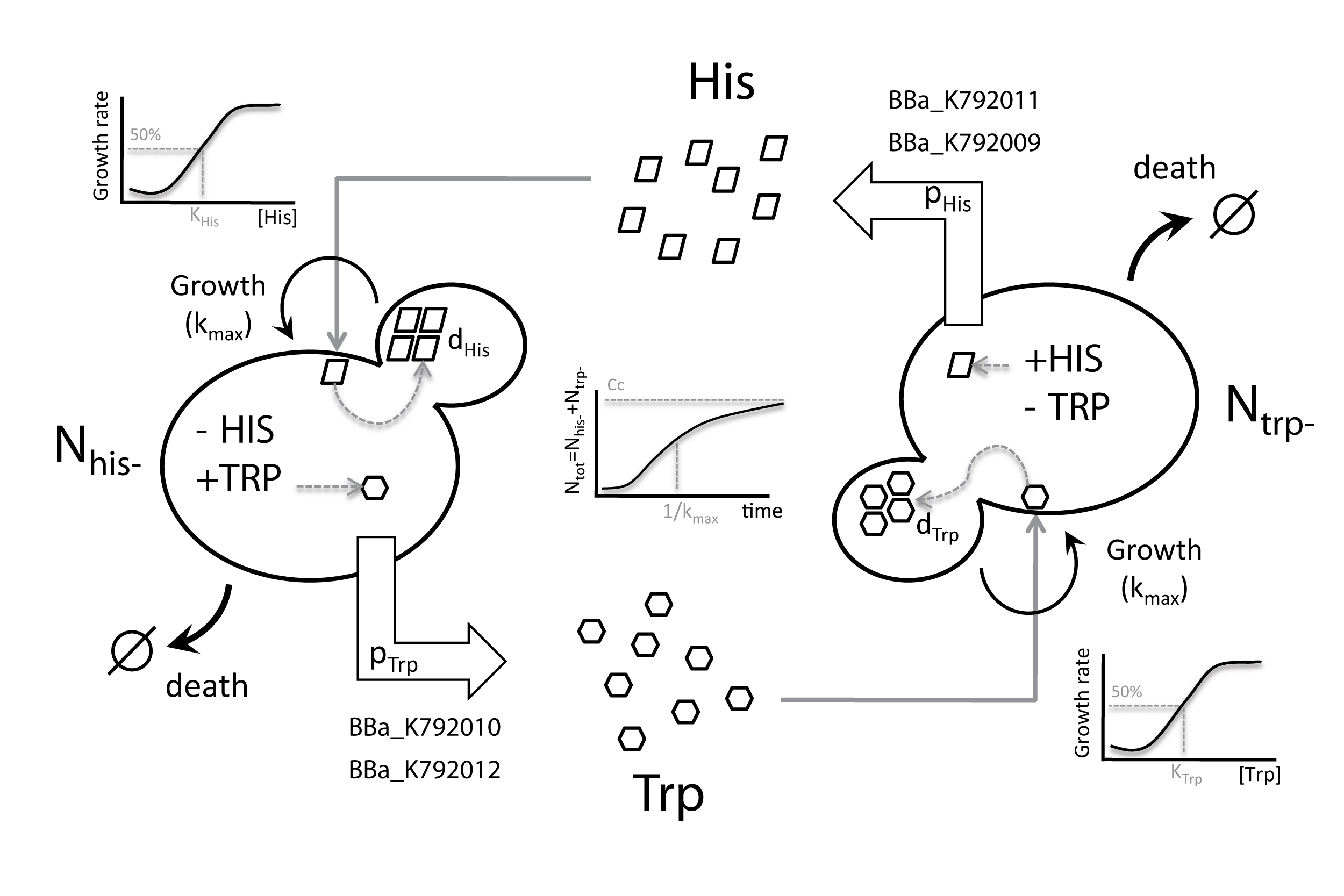Team:Buenos Aires/DataPage
From 2012.igem.org
(Difference between revisions)
Manugimenez (Talk | contribs) (Created page with "{{:Team:Buenos_Aires/Templates/menu}} = Data Page = We built 2 '''His-export devices''', and 2 '''Trp-export devices''': * His-export I (<partinfo>BBa_K792009</partinfo>) * ...") |
Manugimenez (Talk | contribs) (→Data Page) |
||
| (One intermediate revision not shown) | |||
| Line 4: | Line 4: | ||
= Data Page = | = Data Page = | ||
| + | [[File:Crossfeeding-v03-small.png | 700px]] | ||
| + | In order for the cross-feeding scheme to work we need each strain to export the amino acid they produce (either Histidine or Tryptophan). To achieve this we created a devices design to secrete to the medium an His (or Trp) rich peptides. | ||
| + | |||
| + | {| style="width: 100%" | ||
| + | | align="center" | [[File:Crossfeeding-device-design_v01.jpg]] | ||
| + | |- | ||
| + | | align="center" | '''Basic DNA structure of the devices with their constitutive parts''' | ||
| + | |} | ||
| + | |||
| + | |||
| + | * '''Kozak''' consensus sequence for initiation of translation. | ||
| + | * '''Signal peptide''' that targets the product of the gene for secretion. | ||
| + | * '''Trojan peptide''' to increase internalization in target cell. | ||
| + | * '''Payload''': this is the exported amino acid rich domain of the protein. | ||
| + | |||
| + | The input of the devices are ''PoPS'' and the output is secreted amino acids, so the devices are ''PoPS -> exported AA'' transducers. In principle any PoPS generating part can be used. | ||
| + | |||
| + | |||
| + | You can read more about the design process [[Team:Buenos_Aires/Results/Bb1 | here]] | ||
We built 2 '''His-export devices''', and 2 '''Trp-export devices''': | We built 2 '''His-export devices''', and 2 '''Trp-export devices''': | ||
Latest revision as of 03:54, 27 October 2012

Data Page
In order for the cross-feeding scheme to work we need each strain to export the amino acid they produce (either Histidine or Tryptophan). To achieve this we created a devices design to secrete to the medium an His (or Trp) rich peptides.

|
| Basic DNA structure of the devices with their constitutive parts |
- Kozak consensus sequence for initiation of translation.
- Signal peptide that targets the product of the gene for secretion.
- Trojan peptide to increase internalization in target cell.
- Payload: this is the exported amino acid rich domain of the protein.
The input of the devices are PoPS and the output is secreted amino acids, so the devices are PoPS -> exported AA transducers. In principle any PoPS generating part can be used.
You can read more about the design process here
We built 2 His-export devices, and 2 Trp-export devices:
- His-export I (<partinfo>BBa_K792009</partinfo>)
- Trp export I (<partinfo>BBa_K792010</partinfo>)
- His-export II (<partinfo>BBa_K792011</partinfo>)
- Trp export II (<partinfo>BBa_K792012</partinfo>)
To achive this, we had to create several new basic biobricks:
- Kozak sequence from yeast α-factor mating pheromone (MFα1) (<partinfo>BBa_K792001</partinfo>)
- Secretion tag from yeast α-factor mating pheromone (MFα1) (<partinfo>BBa_K792002</partinfo>)
- HIV TAT penetratin (<partinfo>BBa_K792003</partinfo>)
- Polyarginine trojan peptide (<partinfo>BBa_K792004</partinfo>)
- PolyHa, a Histidine rich peptide (His-Tag) (<partinfo>BBa_K792005</partinfo>)
- TrpZipper2, a Tryptophan rich peptide water soluble and monomeric (<partinfo>BBa_K792006</partinfo>)
- PolyHb, a stable Histidine rich peptide designed by us (<partinfo>BBa_K792007</partinfo>)
- PolyWb, a stable Tryptophan rich peptide designed by us(<partinfo>BBa_K792008</partinfo>)
 "
"
